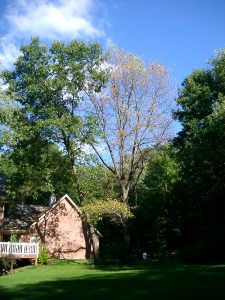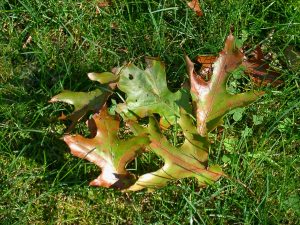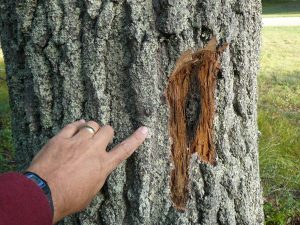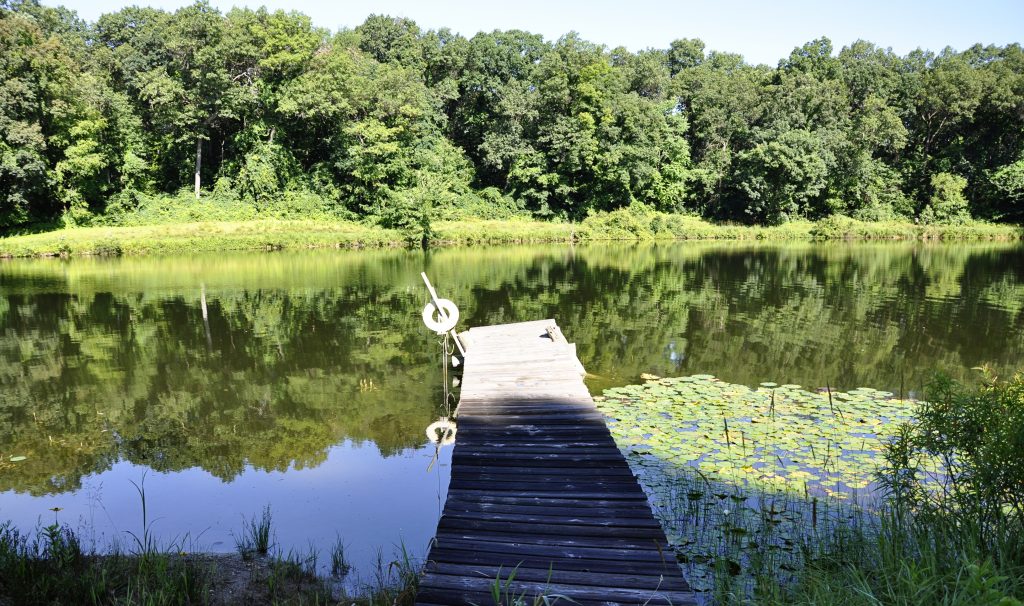By Allene Smith, Land Steward

Oak wilt is an increasingly common forest threat. Photo by Rebecca Finneran, MSU Extension.
You might have heard through the grapevine (or through root grafts, in this case) that Legacy’s Reichert Nature Preserve has come down with a case of oak wilt. While we lay the groundwork for remediation efforts on the Preserve, we’d like to share what we’ve learned about this increasingly common forest threat that causes oaks to die rapidly.
What is oak wilt?
Oak wilt is caused by the fungus Ceratocystis fagacearum and is most lethal to trees in the red oak group. That brings six of Michigan’s native oak species into the crosshairs: northern red oak (Quercus rubra), black oak (Q. velutina), Hill’s oak (a.k.a. northern pin oak, Q. ellipsoidalis), pin oak (Q. palustris), shingle oak (Q. imbricaria), and Shumard oak (Q. shumardii). I’m sure you can imagine that losing these species en masse would drastically change the natural communities we call home.
Oak wilt is often referenced as a new forest threat, but it was identified in Wisconsin circa 1940. Similar mortality patterns were recorded in Wisconsin and Minnesota as early as 1912. The disease has become more prevalent in the past 20 years, possibly due to changes in land use and forest management.

Leaves showing the effects of oak wilt. Photo by Rebecca Finneran, MSU Extension.
How oak wilt impacts trees
Once infected, trees wilt and die rapidly, sometimes within weeks. The most visible symptom is leaf scorching and defoliation. Infected trees often drop leaves while they are still green. The following season, fungal mats (known as pressure pads) develop under the surface of the bark.
Cracks form and allow sap-feeding beetles access to the sweet, yeasty-smelling fungus beneath. These beetles deposit spores from their fungal frolic on the next oak they visit and the cycle starts anew. Once oak wilt claims one tree in an area, the disease can spread through connections in the trees’ root systems called root grafts.

Damage to an oak’s bark can expose the tree to the oak wilt fungus. Photo by Bill Cook, MSU Extension.
What can we do?
As with other forest management issues, prevention offers the biggest reward. The beetles that carry spores can only spread the disease to a wounded tree. Consequently, experts recommend avoiding pruning oaks from just prior to bud opening to after leaf drop (roughly from April to October). If you must prune during the growing season, use wound paint. If you hire a professional tree service, look for one that is aware of oak wilt and doesn’t use climbing spikes.
Remediation for oak wilt is costly and drastically disturbs the treated area, making prevention all the more attractive! Preventing infection through conscientious pruning and maintenance of storm-damaged trees has an impact beyond the individual trees you care for—it impacts the entire forest.
There are many other reasons a tree might be ailing, so proper diagnosis is paramount. If you think a tree near you might be infected with oak wilt, please let us know. We’d be glad to help you find resources in your area.
What happened next? See Part 2, Staying ahead of oak wilt.
This article first appeared in our Winter 2017 newsletter, which you can download to read in full.

Oak trees make up a large portion of the forest at Reichert Nature Preserve. Legacy is treating oak wilt to keep the forest looking as beautiful and healthy as you see here.

 RSS Feed
RSS Feed
Pingback: May Is Oak Wilt Awareness Month – Legacy Land Conservancy | Ann Arbor, MI
Pingback: Oak Wilt On Reichert Preserve, Revisited – Legacy Land Conservancy | Ann Arbor, MI